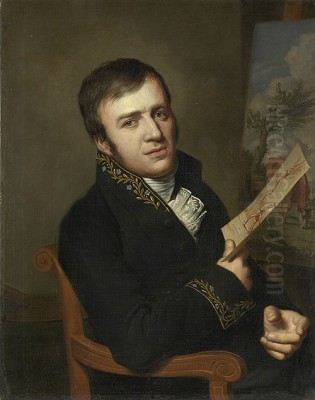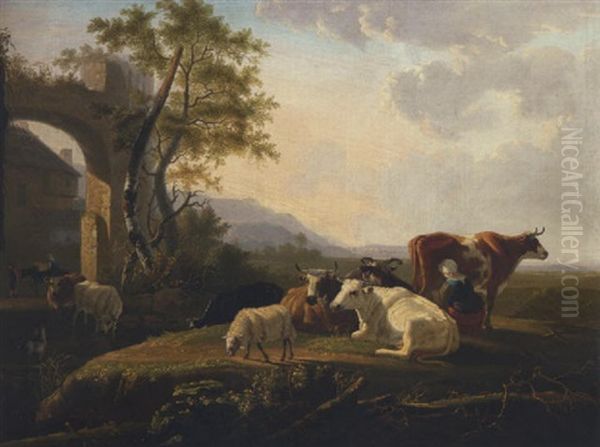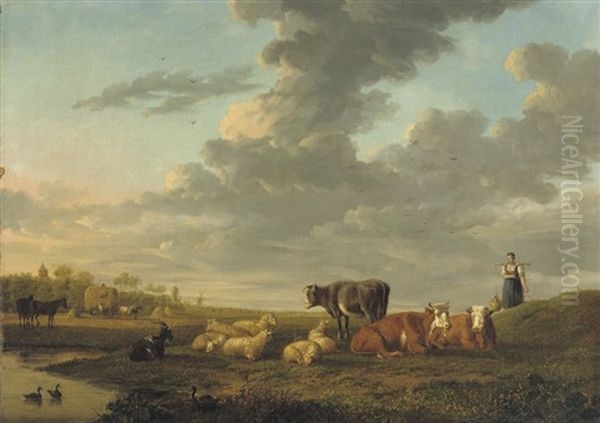
Jan Kobell the Younger, a distinguished figure in Dutch art, carved a notable niche for himself as a painter of animals and landscapes during the late 18th and early 19th centuries. Born in Delfshaven, near Rotterdam, in 1779, he was immersed in an artistic environment from a young age, being the son of the marine painter and etcher Hendrik Kobell. This familial connection to the arts undoubtedly shaped his early inclinations and provided a foundational understanding of painterly traditions. Despite a relatively short life, passing away in Amsterdam in 1814 at the age of 35, Jan Kobell the Younger left behind a body of work that continues to be appreciated for its technical skill, keen observation of nature, and adherence to the rich legacy of Dutch painting.
Early Life and Artistic Formation
Jan Kobell the Younger's artistic journey began under the direct influence of his father, Hendrik Kobell (1751–1779), a respected artist known for his seascapes and drawings. Although his father passed away when Jan was an infant, the artistic legacy of the Kobell family was a palpable presence. His formal training was undertaken with Willem Rutgaart van der Wall (1750-1815) in Utrecht. Van der Wall was a painter of landscapes and wallpaper decorations, and his tutelage would have provided Jan with a solid grounding in the fundamentals of composition and technique, particularly within the landscape genre.
A pivotal aspect of Kobell's development was his intensive study of the Dutch Golden Age masters. He particularly modeled his approach to animal painting on the works of Paulus Potter (1625–1654). Potter was renowned for his incredibly lifelike and detailed depictions of cattle and other livestock set within meticulously rendered Dutch landscapes. By emulating Potter, Kobell sought to capture a similar degree of naturalism, anatomical accuracy, and an empathetic portrayal of his animal subjects. This dedication to studying predecessors like Potter, Aelbert Cuyp (1620–1691), and Adriaen van de Velde (1636–1672), all celebrated for their pastoral scenes and animal artistry, was crucial in shaping his distinctive style.
Artistic Style and Thematic Focus

Jan Kobell the Younger's oeuvre is characterized by a profound dedication to realism and a deep appreciation for the rural Dutch environment. His primary subjects were animals, especially cattle, and landscapes, often combining the two into harmonious pastoral scenes. His style reflects the enduring traditions of 17th-century Dutch art, emphasizing meticulous detail, careful observation of light and atmosphere, and a tranquil, almost idyllic, vision of nature.
In his animal paintings, particularly those featuring cows and sheep, Kobell demonstrated a remarkable ability to render textures – the coarseness of animal hides, the softness of wool, and the varied foliage of their surroundings. He paid close attention to the anatomy and individual characteristics of the animals, imbuing them with a sense of presence and quiet dignity. This approach was directly inherited from masters like Paulus Potter, whose famous work "The Young Bull" (1647) set a high standard for animal portraiture. Kobell, while perhaps not achieving the monumental scale of Potter's most iconic piece, certainly shared his commitment to verisimilitude.
His landscapes, whether serving as backdrops for animal studies or as standalone compositions, depict the flat, water-rich countryside of the Netherlands. He captured the soft, diffused light typical of the region, often with expansive skies that play a significant role in the overall mood of the paintings. These scenes evoke a sense of peace and timelessness, celebrating the unadorned beauty of the Dutch rural setting. His work can be seen as a continuation of the pastoral tradition also explored by artists like Nicolaes Berchem (1620–1683) and Karel Dujardin (1626–1678), who often depicted Italianate landscapes but whose attention to animal life resonated with Dutch sensibilities.
Kobell also produced etchings, a practice common among Dutch artists, including his father. His graphic work would have allowed for a different exploration of form and line, contributing to his overall artistic development and dissemination of his imagery.
Representative Works
Identifying specific, universally acclaimed "masterpieces" for Jan Kobell the Younger can be challenging due to his relatively short career and the fact that several artists in the Kobell family shared similar names and thematic interests, sometimes leading to confusion in attributions. However, his reputation rests firmly on his skillfully executed paintings of cattle and landscapes.

Works generally attributed to him often feature titles descriptive of their content, such as "Landscape with Cattle," "Cattle in a Meadow," or "Resting Cows." One specific work often cited is "Landscape: Cattle and Figures," which is held in the collection of the New-York Historical Society. This painting exemplifies his style, showcasing carefully rendered animals within a serene, naturalistic landscape, with figures adding a narrative or scale element.
His paintings of cattle are particularly noteworthy. These are not generic representations but often studies of individual animals, capturing their placid nature and physical characteristics with precision. The Amsterdam Museum (formerly Amsterdams Historisch Museum) and the Museum Boijmans Van Beuningen in Rotterdam are known to hold examples of his work, particularly his esteemed cattle paintings. These pieces would demonstrate his mastery in capturing the textures of hide, the play of light on the animals' forms, and their integration into the surrounding environment.
While a singular, iconic painting like Potter's "The Young Bull" might not define his legacy, the consistent quality and charm of his numerous animal and landscape scenes collectively form his representative body of work. His dedication to the tradition of Dutch realism, combined with his technical proficiency, ensured that his paintings were highly regarded during his lifetime and continue to be valued.
The Parisian Sojourn and Recognition
A significant event in Jan Kobell the Younger's career was his journey to Paris, which occurred at some point before 1812. During this period, Paris was the undisputed center of the European art world, dominated by Neoclassicism under figures like Jacques-Louis David (1748–1825) and his pupils, such as Jean-Auguste-Dominique Ingres (1780–1867) who was just beginning to make his mark. While Kobell's style was rooted in a different tradition – Dutch realism rather than Neoclassical idealism – his work found favor.
In Paris, Kobell's paintings received considerable acclaim from art critics, and he was awarded a gold medal for his artistic achievements. This recognition in such a competitive and prestigious artistic hub was a testament to the quality and appeal of his work. It suggests that his meticulous rendering, naturalism, and the charming subject matter of his Dutch pastoral scenes resonated even within an art scene largely focused on historical, mythological, and allegorical themes on a grand scale.
The exact duration of his stay and the specific interactions he had with French artists of the time, such as Antoine-Jean Gros (1771–1835) or Théodore Géricault (1791–1824), who himself showed a keen interest in animal anatomy and realism, are not extensively documented. However, the honor he received indicates that his distinctively Dutch approach was appreciated for its unique qualities and technical excellence. This Parisian success would have undoubtedly enhanced his reputation both abroad and back in the Netherlands.
Contemporaries and Artistic Milieu
Jan Kobell the Younger operated within a rich artistic context, both in the Netherlands and during his time in Paris. His work should be seen in relation to several groups of artists.
Firstly, the towering figures of the Dutch Golden Age, whose influence was paramount:
Paulus Potter (1625–1654): As mentioned, Potter was Kobell's primary model for animal painting.
Aelbert Cuyp (1620–1691): Known for his luminous landscapes, often featuring cattle, bathed in a golden light.
Adriaen van de Velde (1636–1672): A master of pastoral scenes, delicate figures, and exquisitely painted animals.
Nicolaes Berchem (1620–1683) and Karel Dujardin (1626–1678): Though often associated with Italianate landscapes, their skill in depicting livestock and rural life was part of the broader Dutch tradition.
Philips Wouwerman (1619–1668): Celebrated for his dynamic scenes with horses, showcasing exceptional skill in animal anatomy and movement.
Secondly, his direct teacher and Dutch contemporaries:
Willem Rutgaart van der Wall (1750-1815): His instructor in Utrecht, providing foundational training.
Wouter Johannes van Troostwijk (1782–1810): A contemporary animal and landscape painter whose promising career was cut short even earlier than Kobell's. His work shares similarities in its focus on naturalism.
Later 19th-century Dutch Romantic painters like Barend Cornelis Koekkoek (1803–1862) would continue the Dutch landscape tradition, building upon the foundations laid by artists like Kobell and their 17th-century predecessors, though Koekkoek's style evolved towards a more Romantic sensibility.
Thirdly, the Parisian artistic environment around 1812:
Jacques-Louis David (1748–1825): The leading figure of Neoclassicism, whose grand historical paintings set the dominant tone.
Antoine-Jean Gros (1771–1835): A pupil of David, known for his large-scale paintings of Napoleonic campaigns, bridging Neoclassicism and emerging Romanticism.
Jean-Auguste-Dominique Ingres (1780–1867): Another prominent Neoclassicist, famed for his portraits and historical scenes, emphasizing linear purity.
Théodore Géricault (1791–1824): A pioneer of French Romanticism, whose interest in contemporary subjects, dynamic compositions, and animal studies (e.g., horses) offered a contrast to strict Neoclassicism. While Kobell's style was different, Géricault's own meticulous study of animal anatomy might have found some common ground with Kobell's detailed animal depictions.
Pierre-Paul Prud'hon (1758–1823): An artist whose softer, more allegorical style offered an alternative to the severity of Davidian Neoclassicism.
Kobell's success in Paris, despite the prevailing Neoclassical taste, highlights an appreciation for diverse artistic traditions and the enduring appeal of skillfully rendered naturalism.
The Kobell Artistic Dynasty
Jan Kobell the Younger was part of a notable family of artists, which spanned several generations and various specializations. Understanding this context helps to situate his own contributions.
Hendrik Kobell (1751–1779): His father, a marine painter, draughtsman, and etcher. He was known for his seascapes and depictions of ships. His early death meant he wasn't a direct, long-term mentor to Jan, but his artistic reputation would have been an influence.
Jan Kobell I (also known as Jan Kobell the Elder, 1756–1833): Uncle of Jan Kobell the Younger. He was a painter of landscapes and cattle, and also an engraver. The similarity in names and subject matter between Jan Kobell I and Jan Kobell the Younger (1779-1814) can sometimes lead to confusion in art historical records.
Anna Kobell (1790–1847): Sister of Jan Kobell the Younger. She was also an artist, known for her paintings of landscapes and still lifes, working in a style influenced by her family's artistic traditions. She was a pupil of her brother Jan.
Wilhelm von Kobell (1766–1853): A cousin of Jan Kobell the Younger (son of Ferdinand Kobell, who was Hendrik's brother). Wilhelm became a very prominent German painter, particularly known for his landscapes, battle scenes, and animal paintings. He worked for the Bavarian court and achieved significant fame. His style evolved from a Dutch-influenced realism towards a more luminous, almost Biedermeier clarity.
Jan Kobell (II) (1800–1838): Son of Jan Kobell I (and thus a cousin to Jan Kobell the Younger, 1779-1814). He was also a painter of landscapes and cattle, continuing the family tradition. The existence of multiple "Jan Kobells" specializing in similar subjects underscores the need for careful attribution of works. For instance, a large cattle painting completed in 1830, sometimes mentioned in relation to "Jan Kobell," would more likely be by this Jan Kobell (II) or Jan Kobell I, given that Jan Kobell the Younger (1779-1814) had passed away sixteen years prior.
This artistic lineage demonstrates a strong tradition of art-making within the Kobell family, with a particular emphasis on landscape and animal subjects, reflecting the enduring appeal of these genres in Dutch and German art.
Legacy and Collections
Jan Kobell the Younger's legacy lies in his contribution to the Dutch tradition of animal and landscape painting at the turn of the 19th century. He successfully carried forward the meticulous realism and intimate observation of nature that characterized the Golden Age masters, adapting it with his own refined sensibility. His work served as a bridge between the 17th-century masters he revered and later 19th-century developments in Dutch landscape art.
His paintings were sought after by collectors during his lifetime and continue to be held in public and private collections. Key institutions that house his works include:
Rijksmuseum, Amsterdam: As the premier museum for Dutch art, the Rijksmuseum holds a significant collection of paintings from this period and would be a likely repository for works by Kobell, reflecting his place within the national school.
Amsterdam Museum (formerly Amsterdams Historisch Museum): Known to have fine examples of his cattle paintings.
Museum Boijmans Van Beuningen, Rotterdam: This museum also has a strong collection of Dutch art and is cited as holding his cattle paintings.
New-York Historical Society: Holds the aforementioned "Landscape: Cattle and Figures."
His influence on subsequent artists might not have been as transformative as that of some of his more revolutionary contemporaries in France, but within the realm of Dutch animal and landscape painting, he maintained a high standard of quality and fidelity to nature. His success in Paris also demonstrated the international appeal of Dutch artistic traditions. The detailed, naturalistic portrayal of animals and landscapes remained a cherished aspect of art, and Kobell's contributions helped to sustain this appreciation.
Conclusion
Jan Kobell the Younger, despite his premature death, made a significant mark as a painter of animals and landscapes. Steeped in the rich traditions of Dutch art and deeply influenced by masters like Paulus Potter, he developed a style characterized by meticulous detail, anatomical accuracy, and a serene depiction of the natural world. His journey to Paris and the accolades he received there underscore the quality and appeal of his work on an international stage. As a member of the distinguished Kobell artistic family, he played a vital role in continuing and enriching the legacy of Dutch realism. His paintings remain a testament to his skill, his keen eye for nature, and his dedication to the enduring beauty of the Dutch countryside and its inhabitants, securing his place as a respected, if sometimes overlooked, master of his era.